The Boeing 707 is a four-engine narrow-body commercial passenger jet airliner developed by Boeing in the early 1950s. Its name is most commonly pronounced as "Seven Oh Seven". The first airline to operate the 707 was Pan American World Airways, inaugurating the type's first commercial flight on October 26, 1958. Boeing delivered a total of 1,011 Boeing 707s including a smaller, faster model of the aircraft that was marketed as the Boeing 720.
Although it was not the first commercial jet in service, the 707 was among the first to be commercially successful. Dominating passenger air transport in the 1960s, and remaining common throughout the 1970s, the 707 is generally credited with ushering in the Jet Age. It established Boeing as one of the largest makers of passenger aircraft, and led to the later series of aircraft with "7x7" designations.
Development
Model 367-80 origins
Boeing, during and immediately after World War II, was known for its military aircraft. The company had produced innovative and important bombers, from the B-17 Flying Fortress and B-29 Superfortress, to the jet-powered B-47 Stratojet and B-52 Stratofortress. The company's civil aviation department lagged far behind Douglas and other competitors, the only noteworthy airliners being the Boeing 314 Clipper and 307 Stratoliner. During 1949–1950, Boeing embarked on serious studies for a new jet transports, realizing that any design must have the potential to fulfill both the military and civil markets. At the time, aerial refueling was increasingly becoming a standard operational technique, with over 800 KC-97 Stratotankers being on order. With the advent of the jet age, a new tanker was required to meets the USAF's fleet of jet-powered bombers; this was where Boeing's new design would potentially win military orders
.Boeing studied numerous wing and engine configurations for its new transport/tanker, some of which were based on the B-47 and C-97, before settling on Model 367-80. The "Dash 80" took less than two years from project launch in 1952 to rollout on May 14, 1954, then first flew on July 15, 1954. It was powered by the Pratt & Whitney JT3C turbojet engine, which was the civilian version of the J57 used on many military aircraft of the day, including the F-100 fighter and the B-52 bomber.
The prototype was conceived as a proof of concept aircraft for both military and civilian use: The United States Air Force was the first customer for the design, using it as the KC-135 Stratotanker midair refueling platform. It was far from certain that the passenger 707 would be profitable. At the time, Boeing was making nearly all of its money from military contracts: Its last passenger transport, the Boeing 377 Stratocruiser, had netted the company a $15 million loss before it was purchased by the Air Force as the KC-97 Stratotanker.
The 132-inch (3,350 mm) fuselage of the Dash 80 was wide enough only to fit two-plus-two seating (in the manner of the Stratocruiser). Answering customers demands and under Douglas competition, Boeing soon realized that this would not provide a viable payload, so decided to widen the fuselage to 144 in (3,660 mm), the same as the KC-135 Stratotanker, which would allow six-abreast seating — and the shared use of the KC-135's tooling. However, Douglas Aircraft had launched its DC-8 with a fuselage width of 147 in (3,730 mm). The airlines liked the extra space, and so Boeing was obliged to increase the 707's cabin width again, this time to 148 in (3,760 mm). This meant that little of the tooling that was made for the Dash 80 was usable for the 707. The extra cost meant the 707 did not become profitable until some years after it would have if these modifications had not been necessary.
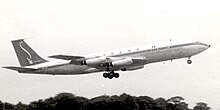
Early production Boeing 707-329 of Sabena in April 1960 retaining the original short tail-fin and no ventral fin
Production and testing
The first flight of the first production 707-120 took place on December 20, 1957, and FAA certification followed on September 18, 1958. A number of changes were incorporated into the production models from the prototype. A Krueger flap was installed along the leading edge between the inner and outer engines on early 707-120 and -320 models.
Further developments
The initial standard model was the 707-120 with JT3C turbojet engines. Qantas ordered a shorter body version called the 707-138, which was a -120 that had six fuselage frames removed, three in front of the wings, three aft. The frames in the 707 were each 20 inches (500 mm) apart, so this resulted in a net shortening of 10 ft (3 m) to 134 ft (41 m), 6 inches (41 m). Because the maximum takeoff weight remained the same 247,000 lb (112 t) as that of the -120, the 138 was able to fly the longer routes that Qantas needed. Braniff International Airways ordered the higher-thrust version with Pratt & Whitney JT4A engines, the 707-220. The final major derivative was the 707-320, which featured an extended-span wing and JT4A engines, while the 707-420 was the same as the -320 but with Rolls-Royce Conway turbofan engines. British certification requirements relating to engine-out go-arounds also forced Boeing to increase the height of the tail fin on all 707 variants, as well as add a ventral fin, which was retrofitted on earlier -120 and -220 aircraft. These modifications also aided in the mitigation of dutch roll by providing more yaw stability.

A Pakistan International Airlines Boeing 707 photographed in Germany, 1961
Though initially fitted with turbojet engines, the dominant engine for the Boeing 707 family was the Pratt & Whitney JT3D, a turbofan variant of the JT3C with lower fuel consumption as well as higher thrust. JT3D-engined 707s and 720s were denoted with a "B" suffix. While many 707-120Bs and 720Bs were conversions of existing JT3C-powered machines, 707-320Bs were available only as newly-built aircraft, as they had a stronger structure to support a maximum take-off weight increased by 19,000 lb (8,600 kg), along with minor modifications to the wing. The 707-320B series enabled non-stop westbound flights from Europe to the US west coast.
The final 707 variant was the 707-320C, (C for "Convertible"), which was fitted with a large fuselage door for cargo applications. This aircraft also had a significantly revised wing featuring three-section leading-edge flaps. This provided an additional improvement to takeoff and landing performance, and also allowed the ventral fin to be removed (although the taller fin was retained). 707-320Bs built after 1963 used the same wing as the -320C and were known as 707-320B Advanced aircraft.
Production of the passenger 707 ended in 1978. In total, 1,010 707s were built for civil use, though many of these found their way to military service. The purpose-built military variants remained in production until 1991.
Traces of the 707 are still found in the 737, which uses a modified version of the 707's fuselage, as well as the same external nose and cockpit configuration as the those of 707. These were also used on the previous Boeing 727, while the Boeing 757 also used the 707 fuselage cross-section. The Chinese government sponsored development of the Shanghai Y-10 during the 1970s, which was a near-carbon-copy of the 707; however, this did not enter production.
Design
Wings

The 4 wheel landing gear bogies on a 707-120
The 707 wings are swept back at 35 degrees and, like all swept-wing aircraft, displayed an undesirable "Dutch roll" flying characteristic that manifested itself as an alternating yawing and rolling motion. Boeing already had considerable experience with this on the B-47 and B-52, and had developed the yaw damper system on the B-47 that would be applied to later swept wing configurations like the 707. However, many new 707 pilots had no experience with this phenomenon, as they were transitioning from straight-wing propeller-driven aircraft such as the Douglas DC-7 and Lockheed Constellation.
On one customer acceptance flight, where the yaw damper was turned off to familiarize the new pilots with flying techniques, a trainee pilot's actions violently exacerbated the Dutch Roll motion and caused three of the four engines to be torn from the wings. The plane, a brand new 707-227, N7071, destined for Braniff, crash-landed on a river bed north of Seattle at Arlington, Washington, killing four of the eight occupants.
In his autobiography, test pilot Tex Johnston described a Dutch Roll incident he experienced as a passenger on an early commercial 707 flight. As the aircraft's movements did not cease and most of the passengers became ill, he suspected a misrigging of the directional autopilot (yaw damper). He went to the cockpit and found the crew unable to understand and resolve the situation. He introduced himself and relieved the ashen-faced captain who immediately left the cockpit feeling ill. Johnston disconnected the faulting autopilot and manually stabilized the plane "with two slight control movements".
Engines

View of number 1 (top left) and 2 (center) Pratt & Whitney JT3D jet engines on the port side of a British Caledonian Boeing 707-320B. The number 1 engine mount (top) is different from the other three engines.
The 707s used engine-driven turbocompressors to supply high-pressure air for pressurization. The engines could not supply sufficient bleed air for this purpose without a serious loss of thrust. On many commercial 707s, the outer port (#1) engine mount is distinctly different from the other three, as this is the only engine not fitted with a turbocompressor. With engines 2 through 4 being fitted with TCs, they provide the triple redundancy required of the aircraft's cabin pressurization and air-conditioning system.
The P&W JT3D-3B engines are readily identifiable by the large gray secondary air inlet doors in the nose cowl. These doors are fully open (sucked in at the rear) during takeoff to provide additional air. When the engines are throttled back to cruise, the doors are shut.
Upgraded engines
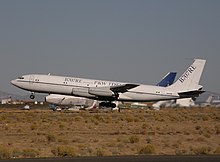
Omega Air's 707-330C testbed for the 707RE program takes off from the Mojave Airport
Pratt & Whitney, in a joint venture with Seven Q Seven (SQS) and Omega Air, has developed the JT8D-219 as a re-engine powerplant for Boeing 707-based aircraft, calling their modified configuration a 707RE. Northrop Grumman has selected the -219 to re-engine the United States Air Force's fleet of 19 E-8 Joint STARS aircraft, which will allow the J-STARS more time on station due to the engine's greater fuel efficiency. NATO also plans to re-engine their fleet of E-3 Sentry AWACS aircraft. The -219 is publicized as being half the cost of the competing 707 re-engine powerplant, the CFM International CFM56, and is 40 dB quieter than JT3D engines that are being replaced.
Operational history
The first commercial orders for the 707 came on October 13, 1955, when Pan Am committed to 20 707s and 25 Douglas DC-8s, a dramatic increase in passenger capacity over its existing fleet of propeller aircraft. The competition between the 707 and DC-8 was fierce. Several major airlines committed only to the DC-8, as Douglas Aircraft was a more established maker of passenger aircraft at the time. To stay competitive, Boeing made a late and costly decision to redesign and enlarge the 707's wing to help increase range and payload. The new version was numbered 707-320.
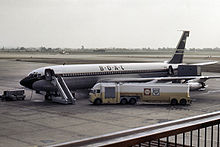
Conway-powered BOAC 707-436 at London Heathrow Airport in 1964.
Pan Am was the first airline to operate the 707; the aircraft's first commercial flight was from New York to Paris on October 26, 1958 with a fuel stop in Gander, Newfoundland. In December, National Airlines operated the first U.S. domestic jet airline flights between New York/Idlewild and Miami, using 707s leased from Pan Am; American Airlines was the first domestic airline to fly its own jets, on January 25, 1959. TWA started domestic 707-131 flights in March and Continental Airlines started 707-124 flights in June; airlines that had ordered only the DC-8, such as United, Delta, and Eastern, were left jetless until September and lost market share on transcontinental flights.
The 707 quickly became the most popular jetliner of its time. Its popularity led to rapid developments in airport terminals, runways, airline catering, baggage handling, reservations systems, and other air transport infrastructure. The advent of the 707 also led to the upgrading of air traffic control systems to prevent interference with military jet operations.
As the 1960s drew to a close, the exponential growth in air travel led to the 707's being a victim of its own success. The 707 was now too small to handle the increased passenger densities on the routes for which it was designed. Stretching the fuselage was not a viable option because the installation of larger, more powerful engines would in turn need a larger undercarriage, which was not feasible given the design's limited ground clearance. Boeing's answer to the problem was the first twin-aisle airliner — the Boeing 747. The 707's first-generation engine technology was also rapidly becoming obsolete in the areas of noise and fuel economy.
In 1982, during the Falklands War the Argentine Air Force extensively used civilian 707s for long-range maritime patrol, with some of them being intercepted and shepherded away by Royal Navy Sea Harriers, it also led to the conversion of British Nimrods to carry Sidewinder air-to-air missiles after a casual encounter.
Trans World Airlines flew the last scheduled 707 flight for passengers by a US carrier on October 30, 1983, although 707s remained in scheduled service by airlines from other nations for much longer. For example, Middle East Airlines (MEA) of Lebanon flew 707s and 720s in front-line passenger service until the end of the 1990s. Since LADE of Argentina took its 707-320B from regular service in 2007, Saha Air Lines of Iran is the last airline to keep 707s in scheduled passenger service.
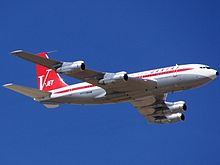
An ex-Qantas Boeing 707-138B, owned by John Travolta, repainted in vintage Qantas livery
In 1984, a Boeing 720 that was flown by remote control was intentionally crashed at Edwards AB as a part of the FAA and NASA Controlled Impact Demonstration program. The test provided peak accelerations during a crash.
Operations of the 707 were threatened by the enactment of international noise regulations in 1985. Shannon Engineering of Seattle, Washington developed a hush kit with funding from Tracor, Inc, of Austin, Texas. By the late 1980s, 172 Boeing 707s had been equipped with the Quiet 707 package. Boeing acknowledged that more 707s were in service then than before the hush kit was available. Most remaining 707s are in freighter form, or as Business Jets.
Honeywell operated the last Boeing 720 in operation in the United States, flying out of Sky Harbor airport in Phoenix. The aircraft had been modified with an extra engine nacelle mounted on the right side of the fuselage to allow testing of a turbine engine at altitude, operating on special certification allowing it to be used for experimental use. This 720B was scrapped on June 21 and 22, 2008. Honeywell replaced their aircraft with a Boeing 757.
Pratt & Whitney Canada flew the last 720 until the end of its operational life in 2010. The final operational flight took place on September 29, 2010 with a decision still to come regarding whether it will be scrapped or placed in a museum. Pratt & Whitney Canada replaced their testbed with a Boeing 747SP.
Variants
Although certificated as Series 100s, 200s, 300s, etc., the different 707 variants are more commonly known as Series 120s, 220s, 320s, and so on, where the "20" part of the designation is Boeing's "customer number" for its development aircraft.
367-80
The 367-80 (Dash-80) was the original prototype Boeing jet transport. Used to develop the KC-135 Stratotanker and the 707, it was fitted with four Pratt & Whitney JT3C engines, each producing 10,000 lbf (44.5 kN). First flight was 15 July 1954. Upon completion of initial test programs, it found use as a flying testbed for new technologies and for continuing improvements to the 707 series. Later fitted with Pratt & Whitney JT3D turbofans, it was retired to storage in Arizona. It is now preserved for public viewing at the Steven F. Udvar-Hazy Center of the Smithsonian National Air and Space Museum (NASM)'s annex near Washington Dulles International Airport.
707-120

Turkish Airlines

Boeing 707-123B cockpit
The 707-120 was the first production 707 variant. The variant featured a longer, wider fuselage, and greater wingspan than the original Dash-80. A full set of rectangular cabin windows was included for the interior, which was capable of a seating 179 passengers. It was designed for transcontinental routes and often required a refuelling stop when used on the North Atlantic route. It was fitted with four Pratt and Whitney JT3C-6 turbojets, civilian versions of the military J57 model, which produced 12,500 lbf (55.6 kN) each, allowing a 247,000 lb (112,000 kg) takeoff gross weight. (Engines on American's 707s started at 13,000 lbf (58 kN) thrust, later increased to 13,500 lbf (60 kN) by increasing the turbine's allowed temperature.) First flight was on December 20, 1957. Major orders were the launch order for 20 707-121 aircraft by Pan American and an American Airlines order for 30 707-123 aircraft. The first revenue service of a 707 was on October 26, 1958. A total of 69 were built.
The 707-138 was based on the -120 but had a 10 ft (3.05 m) reduction to the rear fuselage and were capable of increased range. It was a variant for Qantas and included Boeing customer number of 38 for Qantas. A total of 13 -138s were built.

707-120B (VC-137B) wing, showing the new inboard leading edge from the 720. Also, note the British Airways Concorde G-BOAG to the side.
The 707-120B was the first major upgrade to the design was a re-engining with JT3D-1 turbofans, which were quieter, more powerful, and more fuel-efficient, producing 17,000 lbf (75.6 kN) each, with the later JT3D-3 version giving 18,000 lbf (80 kN). The aircraft also received the wing modifications introduced on the 720. The tailplane was also enlarged on the -120B. A total of 72 of these were built, and many more were converted from 707-120 aircraft, including Qantas' aircraft, which became 707-138B aircraft upon conversion. The first flight of the -120B was on 22 June 1960.
707-220
The 707-220 was designed for hot and high operations with powerful Pratt & Whitney JT4A-3 turbojets, only five of these were produced, however only four were ultimately delivered with one being lost during a test flight. All were for Braniff International Airways and carried the model number 707-227. This version was made obsolete by the arrival of the turbofan-powered 707-120B.
707-320

British Caledonian Boeing 707 shown at Glasgow Prestwick Airport, South Ayrshire, Scotland, c. 1972.
The 707-320 Intercontinental is a stretched version of the turbojet-powered 707-120, initially powered by JT4A-3 or JT4A-5 turbojets producing 15,800 lbf (70,000 N) each. The interior allowed for up to 189 passengers due to an 80-inch (2,000 mm) fuselage stretch (from 138 ft 10 in (42.32 m) to 145 ft 6 in), with extensions to both the tail and horizontal stabilizer extending the aircraft's length further. while a longer wing carried more fuel, increasing range by 1,600 miles (2,600 km) and allowing the aircraft to operate as true transoceanic aircraft. The wing modifications included outboard and inboard inserts, as well as a kink in the trailing edge to add area inboard. Takeoff weight was increased to 302,000 lb (137,000 kg) initially, and to 311,000 lb (141,000 kg) and perhaps further as higher-rated JT4A's became available. First flight was on January 11, 1958, and 69 turbojet 707-320s were produced. No -320 Intercontinental models were re-engined with fan engines in civil use, but around year 2000 the Israeli Air Force re-engined two ex-Sabena -320 based military tankers.
The 707-320B is a re-engined version undertaken in parallel with the -120B, using the same JT3D-3 turbofans and incorporating many of the same airframe upgrades as well. The wing was modified from the -320 by adding a second inboard kink, a dog-toothed leading edge, and triangular wingtips instead of the earlier blunt ones. These new wingtips increased overall wingspan by three feet. Takeoff gross weight was increased to 335,000 lb (152,000 kg). The 175 707-320B aircraft produced were all new-build; no original -320 models were converted to fan engines in civilian use.
The 707-320B Advanced is a slightly improved version of the -320B aircraft, adding three-section leading-edge flaps. These reduced takeoff and landing speeds, and also altered the lift distribution of the wing, allowing the ventral fin found on earlier 707s to be removed. The same wing was also used on the 707-320C.
The 707-320C has a convertible passenger–freight configuration, which became the most widely produced variant of the 707. The 707-320C added a strengthened floor and a new cargo door to the -320B model. Three hundred thirty-five of these variants were built, including a small number with uprated JT3D-7 engines and a takeoff gross weight of 336,000 lb (152,000 kg). Despite the convertible option, a number of these were delivered as pure freighters. One of the final orders was by the Iranian Government for 14 707-3J9C aircraft capable of VIP transportation, communication, and in-flight refuelling tasks.
The 707-420 is a version of the 707-320 originally produced at specific request for BOAC and powered by Rolls-Royce Conway 508 turbofans, producing 17,500 lbf (77.8 kN) each. Although BOAC were first to order the 707-320 delays in getting British certification meant that Lufthansa were the first to receive and operate the 707-320 in February 1960. A total of 37 were built to this configuration.
The 707-700 was a test aircraft used to study the feasibility of using CFM International's CFM56 powerplants on a 707 airframe and possibly retrofitting them to existing aircraft. After a testing in 1979, N707QT, the last commercial 707 airframe, was refitted to 707-320C configuration and delivered to the Moroccan Air Force as a tanker aircraft. (This purchase was considered a "civilian" order and not a military one.) Boeing abandoned the program, since they felt it would be a threat to the Boeing 757 program. The information gathered in the test led to the eventual retrofitting program of CFM56 engines to the USAF C-135/KC-135R models, and some military versions of the 707 also used the CFM56. It is ironic that the Douglas DC-8 "Super 70" series by Cammacorp did develop commercially, extending the life of DC-8 airframes in a stricter noise regulatory environment, so there are today more DC-8s in commercial service than there are 707s.
720

Boeing 720-048 of Aer Lingus-Irish International in 1965
The 720 was originally designated 707-020 but later changed for marketing reasons. It was a modification of the 707-120 designed for medium-range operation from shorter runways. It had four frames removed in front of the wing, and one aft, making it 8 feet 4 inches (2.54 m) shorter than the -120, and was certified to a lower maximum takeoff weight. The wing modifications consisted of adding Krueger flaps outboard of the outboard engines to lower takeoff and landing speeds and thus shorten field length, and a thickened inboard section at the leading edge, which had a slightly greater sweep. This modification increased the top speed over the -120, and was later available on the -120B and on -120s retrofitted to the B standard. This model had few sales but was still profitable due to the minimal R&D costs associated with modifying an existing type. At one point in the promotion stage to airlines, it was known as the 717, although this was the Boeing model designation of the KC-135 and remained unused for a commercial airliner until it was applied to the MD-95 following Boeing's merger with McDonnell Douglas. The 720 was used before the Boeing 727 replaced it in the market. Its first flight was on November 23, 1959, and 64 of the original version were built.
The 720B was the turbofan-powered version of the 720, with JT3D-1-MC6 turbofans producing 17,000 lbf (75.6 kN) each. Takeoff gross weight was increased to 235,000 lb (107,000 kg). A total of 89 of these were built in addition to conversions of existing 720s. Boeing built a combined 154 of both 720 models from 1959 to 1967.
Military
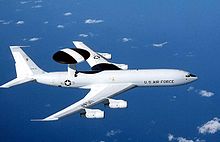
USAF E-3 Sentry in flight

RAAF 707-368C at Perth International airport, Australia
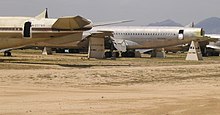
Boeing 707s at AMARG being used for salvage parts for the KC-135s.
The militaries of the United States and other countries have used the civilian 707 aircraft in a variety of roles, and under different designations. (Note the 707 and U.S. Air Force's KC-135 were developed in parallel from the Boeing 367-80 prototype.) The Canadian Forces also operated Boeing 707 with designation CC-137 Husky (707-347C) from 1972 to 1997.
The VC-137C variant of the Stratoliner was a special-purpose design meant to serve as Air Force One, the secure transport for the President of The United States of America. These models were in operational use from 1962 to 1990. The two aircraft remain on display: SAM 26000 is at the National Museum of the United States Air Force near Dayton, Ohio and SAM 27000 is at the Ronald Reagan Presidential Library in Simi Valley, California.
717
Boeing 717 was the company designation for C-135 Stratolifter and KC-135 Stratotanker derivatives of the 367-80. The designation was later re-used in renaming the McDonnell Douglas MD-95 to Boeing 717 after the company was merged with Boeing.
Operators
In the 1980s, the USAF acquired around 250 used 707s to provide parts for the KC-135E Stratotanker program.
Although 707s are no longer employed by major airlines, as of March 2011, 43 aircraft were in use mainly with air cargo operators and air forces in Africa, Middle East, and South America. Commercial operators of the Boeing 707 include Saha Airline, BETA Cargo, Enterprise World Airways, Libyan Airlines, Mid Express Tchad, Hewa Bora Airways, and some other users with mostly stored aircraft. The Romanian Government uses a 707-320C as a Presidential Aircraft, being operated by Romavia. American actor John Travolta owns, and is qualified to fly as second in command, an ex-Qantas 707-138B, registration N707JT.
The list of customer codes used by Boeing to identify specific options and trim specified by customers was started with the 707, and has been maintained through all Boeing's models. In essence the same system as used on the earlier Boeing 377, the code consisted of two digits affixed to the model number to identify the specific aircraft version. For example, Pan American Airlines was assigned code "21". Thus, a 707-320B sold to Pan Am had the model number 707-321B. The number remained constant as further aircraft were purchased; thus, when Pan American purchased the 747-100 it had the model number 747-121.
Specifications
| 720 (707-020) | 707-120B | 707-320B | |
|---|---|---|---|
| Cockpit crew | Three | ||
| Passengers | 140 | 110 (2 class) 179 (1 class) | 147 (2 class) 202 (1 class) |
| Length | 136 ft 2 in (41.25 m) | 145 ft 1 in (44.07 m) | 152 ft 11 in (46.61 m) |
| Wingspan | 130 ft 10 in (39.90 m) | 145 ft 9 in (44.42 m) | |
| Tail height | 41 ft 7 in (12.65 m) | 42 ft 5 in (12.93 m) | |
| Maximum Takeoff Weight (MTOW) | 222,000 lb (100,800 kg) | 257,000 lb (116,570 kg) | 333,600 lb (151,320 kg) |
| Empty weight | 103,145 lb (46,785 kg) | 122,533 lb (55,580 kg) | 146,400 lb (66,406 kg) |
| Runway needed at MTOW | 8,300 ft (2,515 m) | 11,000 ft (3,330 m) | 10,840 ft (3,280 m) |
| Fuel Capacity | 16,060 US gal (60,900 l) | 17,330 US gal (65,590 l) | 23,820 US gal (90,160 l) |
| Landing run | 5,750 ft (1,740 m) | 6,200 ft (1,875 m) | 5,950 ft (1,813 m) |
| Operating range (Max Payload) | 3,680 nmi (6,820 km) | 3,735 nmi (6,920 km) | |
| Range at MTOW (max fuel) | 3800 nmi (7,040 km) | 4,700 nmi (8,704 km) | 5,750 nmi (10,650 km) |
| Cruising speed | 540 kn (1000 km/h) | 525 kn (972 km/h) | |
| Fuselage width | 12 ft 4 in (3.76 m) | ||
| Powerplants (4 x) | Pratt & Whitney JT3C-7: 12,000 lbf (53.3 kN) | Pratt & Whitney JT3D-1: 17,000 lbf (75.6 kN) | PW JT3D-3: 18,000 lbf (80 kN) PW JT3D-7: 19,000 lbf (84.4 kN) |

Αυτό το σχόλιο αφαιρέθηκε από έναν διαχειριστή ιστολογίου.
ΑπάντησηΔιαγραφή